2021 YAMAHA FX SVHO stop start
[x] Cancel search: stop startPage 47 of 116
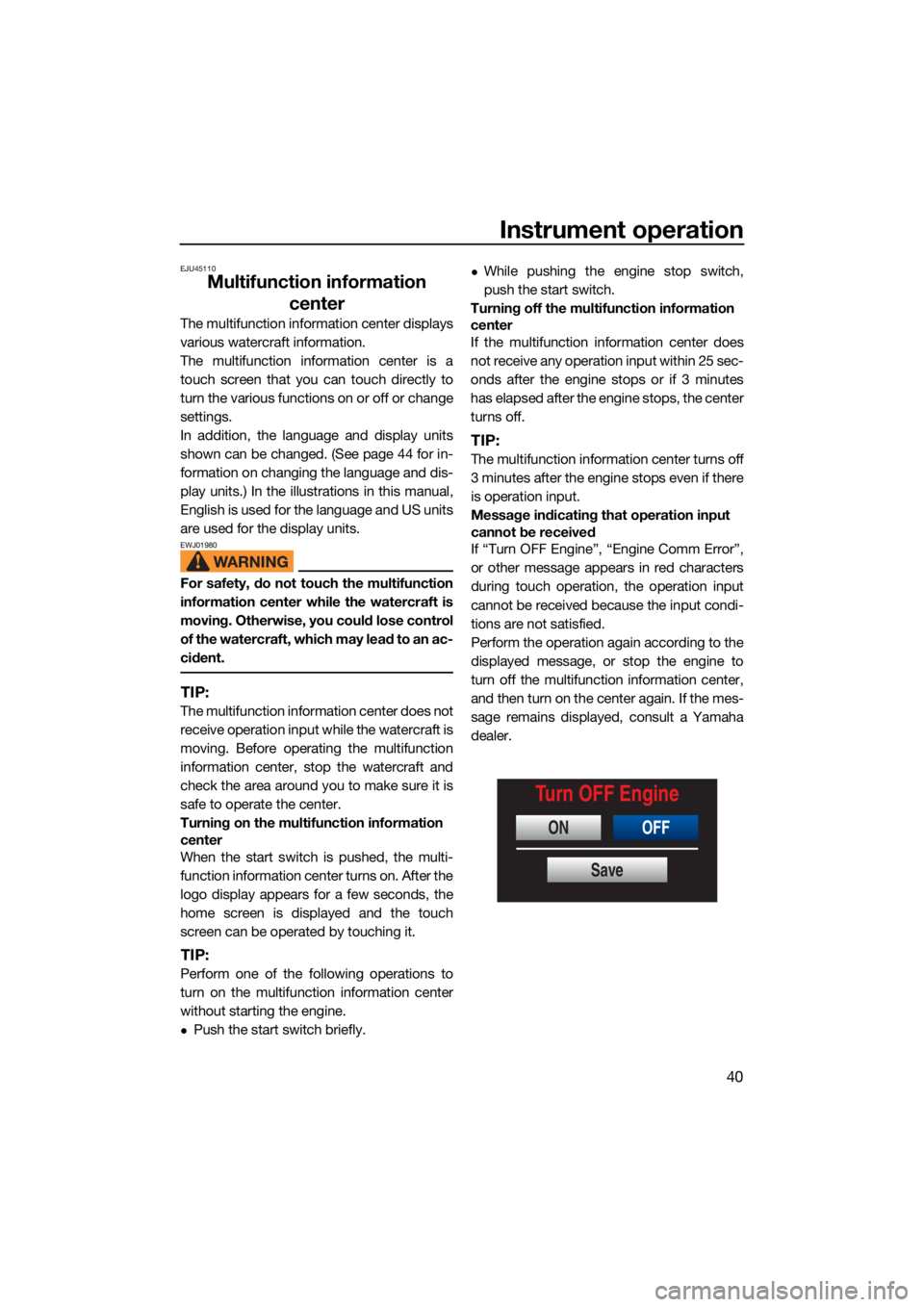
Instrument operation
40
EJU45110
Multifunction information center
The multifunction information center displays
various watercraft information.
The multifunction information center is a
touch screen that you can touch directly to
turn the various functions on or off or change
settings.
In addition, the language and display units
shown can be changed. (See page 44 for in-
formation on changing the language and dis-
play units.) In the illustrations in this manual,
English is used for the language and US units
are used for the display units.
EWJ01980
For safety, do not touch the multifunction
information center while the watercraft is
moving. Otherwise, you could lose control
of the watercraft, which may lead to an ac-
cident.
TIP:
The multifunction information center does not
receive operation input while the watercraft is
moving. Before operating the multifunction
information center, stop the watercraft and
check the area around you to make sure it is
safe to operate the center.
Turning on the multifunction information
center
When the start switch is pushed, the multi-
function information center turns on. After the
logo display appears for a few seconds, the
home screen is displayed and the touch
screen can be operated by touching it.
TIP:
Perform one of the following operations to
turn on the multifunction information center
without starting the engine.
Push the start switch briefly.
While pushing the engine stop switch,
push the start switch.
Turning off the multifunction information
center
If the multifunction information center does
not receive any operation input within 25 sec-
onds after the engine stops or if 3 minutes
has elapsed after the engine stops, the center
turns off.
TIP:
The multifunction information center turns off
3 minutes after the engine stops even if there
is operation input.
Message indicating that operation input
cannot be received
If “Turn OFF Engine”, “Engine Comm Error”,
or other message appears in red characters
during touch operation, the operation input
cannot be received because the input condi-
tions are not satisfied.
Perform the operation again according to the
displayed message, or stop the engine to
turn off the multifunction information center,
and then turn on the center again. If the mes-
sage remains displayed, consult a Yamaha
dealer.
ONOFF
Turn OFF Engine
Save
UF3X72E0.book Page 40 Friday, May 29, 2020 10:09 AM
Page 48 of 116
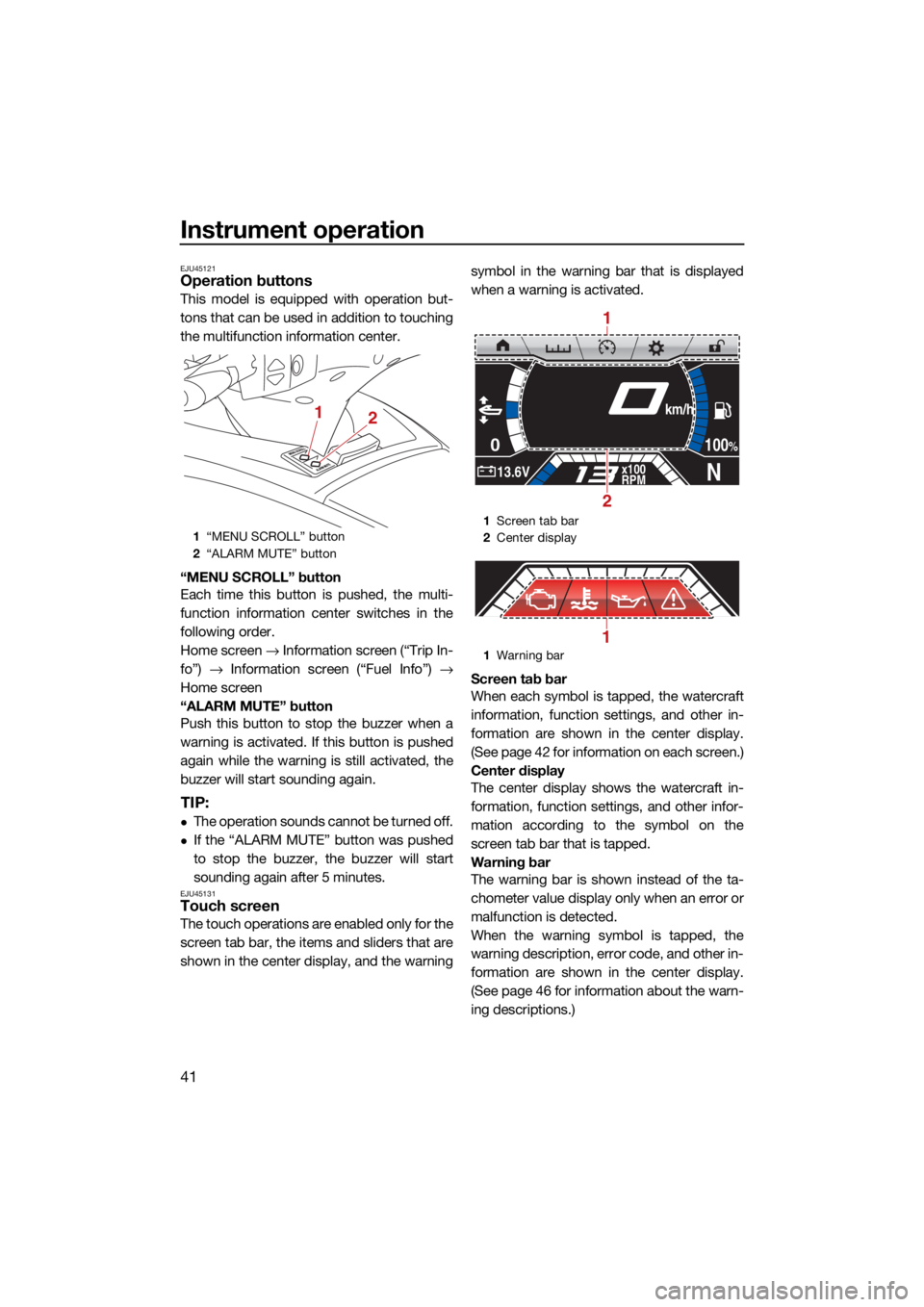
Instrument operation
41
EJU45121Operation buttons
This model is equipped with operation but-
tons that can be used in addition to touching
the multifunction information center.
“MENU SCROLL” button
Each time this button is pushed, the multi-
function information center switches in the
following order.
Home screen → Information screen (“Trip In-
fo”) → Information screen (“Fuel Info”) →
Home screen
“ALARM MUTE” button
Push this button to stop the buzzer when a
warning is activated. If this button is pushed
again while the warning is still activated, the
buzzer will start sounding again.
TIP:
The operation sounds cannot be turned off.
If the “ALARM MUTE” button was pushed
to stop the buzzer, the buzzer will start
sounding again after 5 minutes.
EJU45131Touch screen
The touch operations are enabled only for the
screen tab bar, the items and sliders that are
shown in the center display, and the warning symbol in the warning bar that is displayed
when a warning is activated.
Screen tab bar
When each symbol is tapped, the watercraft
information, function settings, and other in-
formation are shown in the center display.
(See page 42 for information on each screen.)
Center display
The center display shows the watercraft in-
formation, function settings, and other infor-
mation according to the symbol on the
screen tab bar that is tapped.
Warning bar
The warning bar is shown instead of the ta-
chometer value display only when an error or
malfunction is detected.
When the warning symbol is tapped, the
warning description, error code, and other in-
formation are shown in the center display.
(See page 46 for information about the warn-
ing descriptions.)
1
“MENU SCROLL” button
2 “ALARM MUTE” button
12
1Screen tab bar
2 Center display
1 Warning bar
0
N13.6Vx100
RPM
100%
km/h
1
2
1
UF3X72E0.book Page 41 Friday, May 29, 2020 10:09 AM
Page 54 of 116

Instrument operation
47
start the engine again, or push the “ALARM
MUTE” button.
TIP:
If the “ALARM MUTE” button was pushed to
stop the buzzer, the buzzer will start sound-
ing again after 5 minutes.
Fuel level warning
If the amount of remaining fuel is less than
10%, the percentage display of the fuel level
meter changes to “Low”, and the buzzer
sounds intermittently.
If the fuel level warning is activated, refill the
fuel tank as soon as possible. (See page 57
for information on filling the fuel tank.)
Battery voltage warning
If the battery voltage is less than 12 volts or
more than 18 volts when the engine is notrunning, the voltage display of the voltmeter
blinks.
If the battery voltage warning is activated,
have the watercraft serviced by a Yamaha
dealer as soon as possible.
Check engine warning “ ”
If a sensor malfunction or a short circuit is de-
tected, the warning bar is shown instead of
the tachometer value display, “ ” is shown,
and the buzzer sounds intermittently.
If the check engine warning is activated, im-
mediately reduce the engine speed, return to
shore, and have a Yamaha dealer check the
engine.
TIP:
Tap “ ” to display a description of the
warning in the center display.
Engine overheat warning “ ”
If the engine temperature rises significantly,
the warning bar is shown instead of the ta-
chometer value display, “ ” and “ ” are
shown, and the buzzer sounds continuously.
1
“ALARM MUTE” button
1
Low0
F13.6Vx100
RPM
km/h
0
F10.8Vx100
RPM
100%
km/h
UF3X72E0.book Page 47 Friday, May 29, 2020 10:09 AM
Page 68 of 116
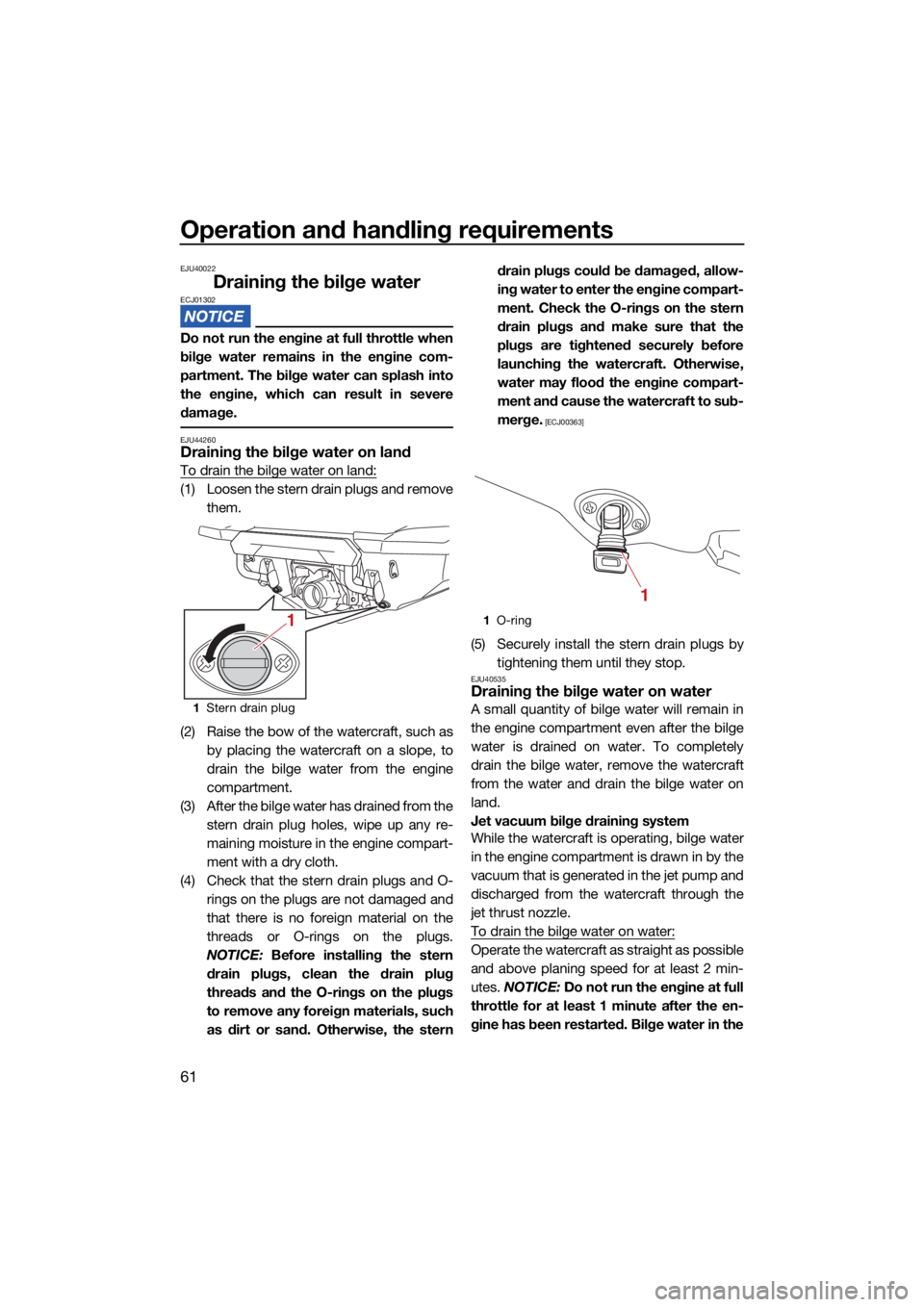
Operation and handling requirements
61
EJU40022
Draining the bilge waterECJ01302
Do not run the engine at full throttle when
bilge water remains in the engine com-
partment. The bilge water can splash into
the engine, which can result in severe
damage.
EJU44260Draining the bilge water on land
To drain the bilge water on land:
(1) Loosen the stern drain plugs and removethem.
(2) Raise the bow of the watercraft, such as by placing the watercraft on a slope, to
drain the bilge water from the engine
compartment.
(3) After the bilge water has drained from the stern drain plug holes, wipe up any re-
maining moisture in the engine compart-
ment with a dry cloth.
(4) Check that the stern drain plugs and O- rings on the plugs are not damaged and
that there is no foreign material on the
threads or O-rings on the plugs.
NOTICE: Before installing the stern
drain plugs, clean the drain plug
threads and the O-rings on the plugs
to remove any foreign materials, such
as dirt or sand. Otherwise, the stern drain plugs could be damaged, allow-
ing water to enter the engine compart-
ment. Check the O-rings on the stern
drain plugs and make sure that the
plugs are tightened securely before
launching the watercraft. Otherwise,
water may flood the engine compart-
ment and cause the watercraft to sub-
merge.
[ECJ00363]
(5) Securely install the stern drain plugs by
tightening them until they stop.
EJU40535Draining the bilge water on water
A small quantity of bilge water will remain in
the engine compartment even after the bilge
water is drained on water. To completely
drain the bilge water, remove the watercraft
from the water and drain the bilge water on
land.
Jet vacuum bilge draining system
While the watercraft is operating, bilge water
in the engine compartment is drawn in by the
vacuum that is generated in the jet pump and
discharged from the watercraft through the
jet thrust nozzle.
To drain the bilge water on water:
Operate the watercraft as straight as possible
and above planing speed for at least 2 min-
utes. NOTICE: Do not run the engine at full
throttle for at least 1 minute after the en-
gine has been restarted. Bilge water in the
1 Stern drain plug
11O-ring
1
UF3X72E0.book Page 61 Friday, May 29, 2020 10:09 AM
Page 71 of 116

Pre-operation checks
64
EJU31982
EWJ00412
Failure to inspect or maintain the watercraft properly increases the possibility of an ac-
cident or damage to the watercraft. Do not operate the watercraft if you find any prob-
lem. If a problem cannot be corrected by the procedures provided in this manual, have
the watercraft inspected by a Yamaha dealer.
EJU41235Pre-operation checklist
Before using this watercraft, be sure to perform the checks in the following checklist.
ITEMROUTINEPAGE
PRE-LAUNCH CHECKS
Engine compartment Ventilate the engine compartment.
Check inside the engine compartment for damage.
66
Fuel system Check the fuel system for leakage.
Check the fuel level in the fuel tank.
66
Water separator Check the water separator for water. 67
Engine unit Check the exterior of the engine unit for damage. 67
Engine oil level Check the engine oil level. 67
Bilge water Check the engine compartment for bilge water. 67
Battery Check the battery connections. 67
Steering system Check the steering system for proper operation. 68
Adjustable tilt steering sys-
tem Check the adjustable tilt steering system for proper
operation and check that the handlebars are se-
curely locked in place.
69
RiDE lever Check the RiDE lever for proper operation. 69
Throttle lever Check the throttle lever for proper operation. 69
Yamaha Security System Check the Yamaha Security System for proper op-
eration.
69
Engine shut-off cord (lan-
yard) Check the engine shut-off cord (lanyard) for dam-
age.
69
Switches Check the start switch, engine stop switch, and en-
gine shut-off switch for proper operation.
69
Electric trim system Check the electric trim system for proper operation. 70
Storage compartments Check the storage compartments for damage and
water.
70
Fire extinguisher holder,
cover, and band Check the fire extinguisher holder, cover, and band
for damage.
70
Fire extinguisher Check the condition of the fire extinguisher. 71
Safety equipment Check that safety equipment meeting the applica-
ble regulations is on board.
71
Hull and deck Check the hull and deck for damage. 71
Jet intake Check the jet intake for damage and clogging. 71
UF3X72E0.book Page 64 Friday, May 29, 2020 10:09 AM
Page 77 of 116
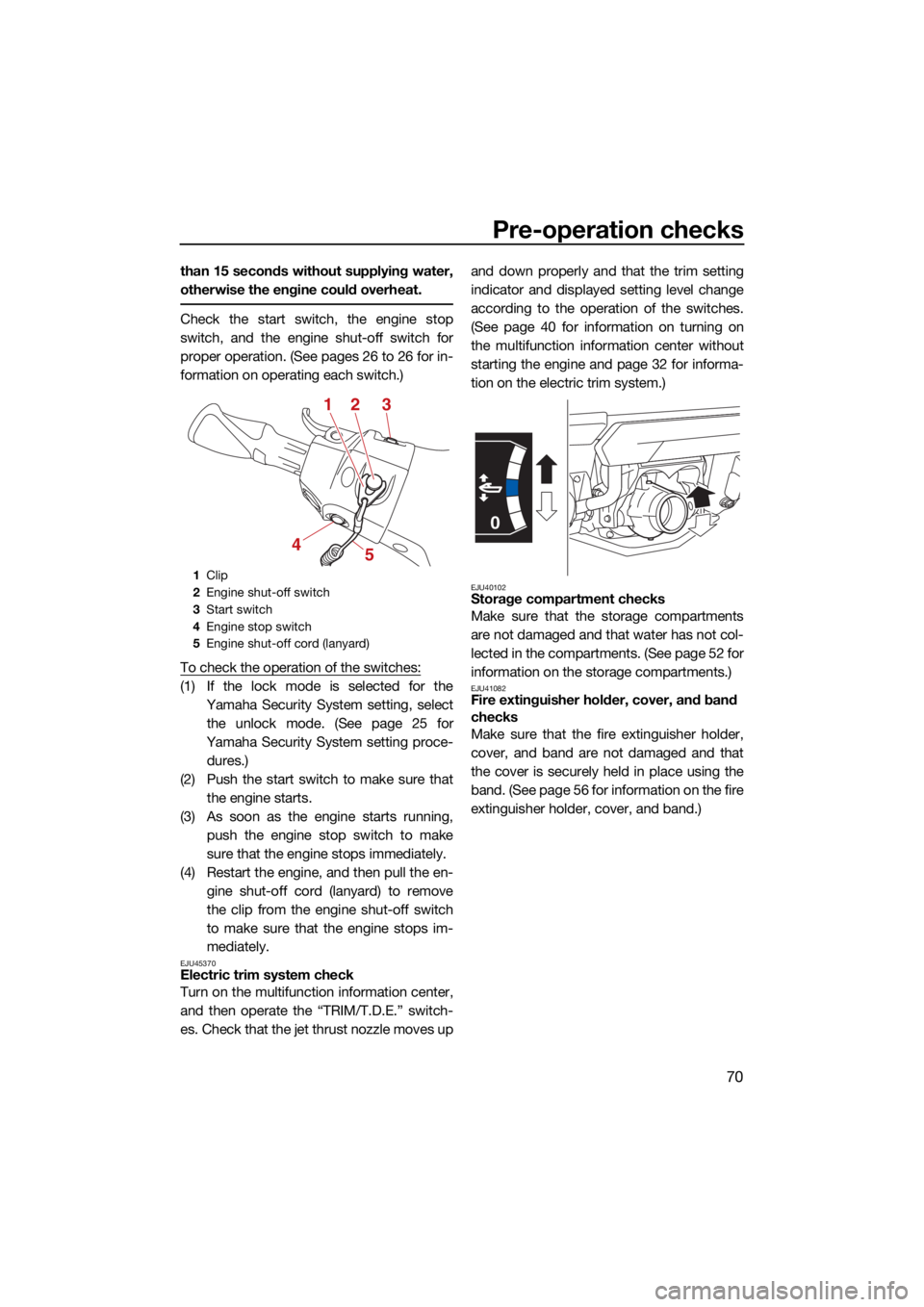
Pre-operation checks
70
than 15 seconds without supplying water,
otherwise the engine could overheat.
Check the start switch, the engine stop
switch, and the engine shut-off switch for
proper operation. (See pages 26 to 26 for in-
formation on operating each switch.)
To check the operation of the switches:
(1) If the lock mode is selected for theYamaha Security System setting, selectthe unlock mode. (See page 25 for
Yamaha Security System setting proce- dures.)
(2) Push the start switch to make sure that the engine starts.
(3) As soon as the engine starts running, push the engine stop switch to make
sure that the engine stops immediately.
(4) Restart the engine, and then pull the en- gine shut-off cord (lanyard) to remove
the clip from the engine shut-off switch
to make sure that the engine stops im-
mediately.
EJU45370Electric trim system check
Turn on the multifunction information center,
and then operate the “TRIM/T.D.E.” switch-
es. Check that the jet thrust nozzle moves up and down properly and
that the trim setting
indicator and displayed setting level change
according to the operation of the switches.
(See page 40 for information on turning on
the multifunction information center without
starting the engine and page 32 for informa-
tion on the electric trim system.)
EJU40102Storage compartment checks
Make sure that the storage compartments
are not damaged and that water has not col-
lected in the compartments. (See page 52 for
information on the storage compartments.)
EJU41082Fire extinguisher holder, cover, and band
checks
Make sure that the fire extinguisher holder,
cover, and band are not damaged and that
the cover is securely held in place using the
band. (See page 56 for information on the fire
extinguisher holder, cover, and band.)
1 Clip
2 Engine shut-off switch
3 Start switch
4 Engine stop switch
5 Engine shut-off cord (lanyard)
12 3
5
4
0
UF3X72E0.book Page 70 Friday, May 29, 2020 10:09 AM
Page 83 of 116
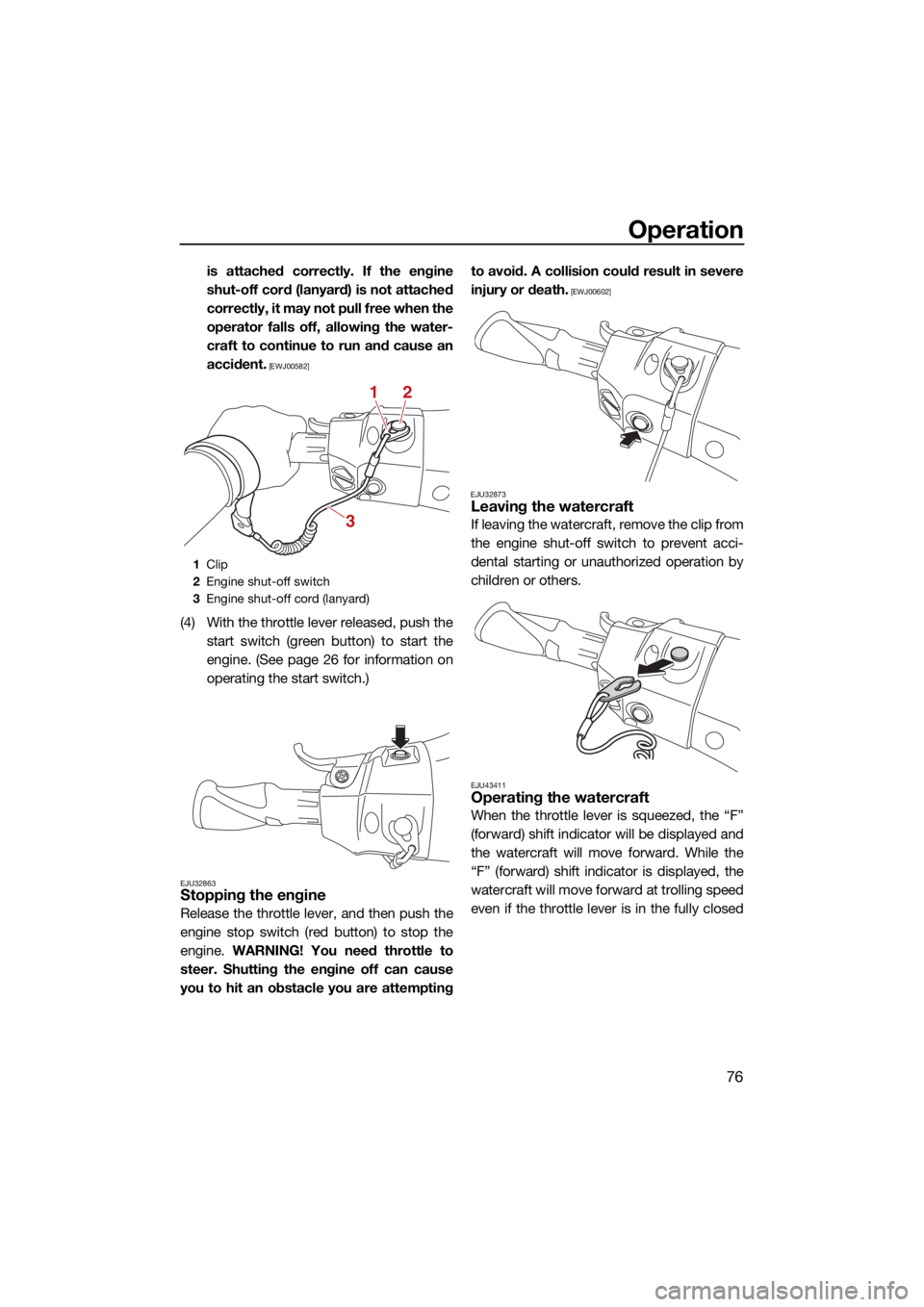
Operation
76
is attached correctly. If the engine
shut-off cord (lanyard) is not attached
correctly, it may not pull free when the
operator falls off, allowing the water-
craft to continue to run and cause an
accident.
[EWJ00582]
(4) With the throttle lever released, push thestart switch (green button) to start the
engine. (See page 26 for information on
operating the start switch.)
EJU32863Stopping the engine
Release the throttle lever, and then push the
engine stop switch (red button) to stop the
engine. WARNING! You need throttle to
steer. Shutting the engine off can cause
you to hit an obstacle you are attempting to avoid. A collision could result in severe
injury or death.
[EWJ00602]
EJU32873
Leaving the watercraft
If leaving the watercraft, remove the clip from
the engine shut-off switch to prevent acci-
dental starting or unauthorized operation by
children or others.
EJU43411Operating the watercraft
When the throttle lever is squeezed, the “F”
(forward) shift indicator will be displayed and
the watercraft will move forward. While the
“F” (forward) shift indicator is displayed, the
watercraft will move forward at trolling speed
even if the throttle lever is in the fully closed
1 Clip
2 Engine shut-off switch
3 Engine shut-off cord (lanyard)
2
3
1
UF3X72E0.book Page 76 Friday, May 29, 2020 10:09 AM
Page 88 of 116

Operation
81
(3) Pull yourself up onto the boarding plat-form and grasp the handgrip, and then
move to the seat and sit astride.
(4) Attach the engine shut-off cord (lanyard) to your left wrist, and then attach the clip
to the engine shut-off switch.
(5) Grip the handlebars with both hands and place both feet on the floor of the foot-
well.
(6) Look in all directions, start the engine, and then start off slowly.
EJU43260Boarding with passenger(s)EWJ01800
Severe internal injuries can occur if wa-
ter is forced into body cavities as a re-
sult of being near the jet thrust nozzle.
Do not start the engine until the passen-
gers are seated with their feet on the
floor of the footwell and are securely holding on to the person in front of them
or to the handgrip provided.
Before boarding the watercraft, make
sure that the engine is stopped. If the
engine is running, the reverse gate may
move down and a person boarding
could be pinched.
The heavier the total weight of the operator
and passenger(s), the more difficult it will be
to balance the watercraft. Do not operate the
watercraft when the total weight exceeds 240
kg (530 lb) including any cargo.
To board with passenger(s):
(1) Board as noted in the previous section
“Boarding alone”.
(2) Grip the handlebars with both hands and place both feet on the floor of the foot-
well.
(3) Have the first passenger move to the rear of the watercraft.
UF3X72E0.book Page 81 Friday, May 29, 2020 10:09 AM